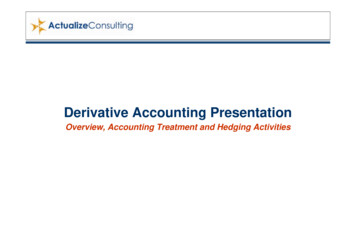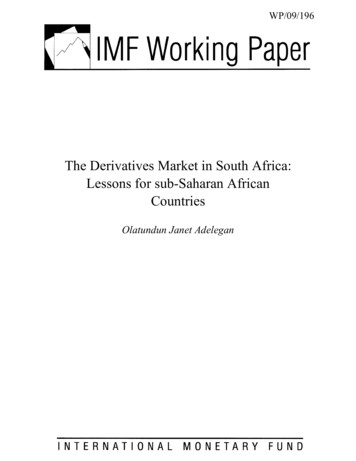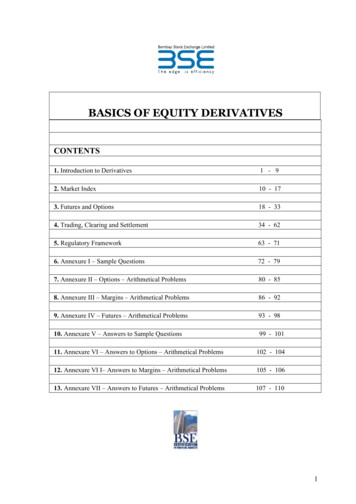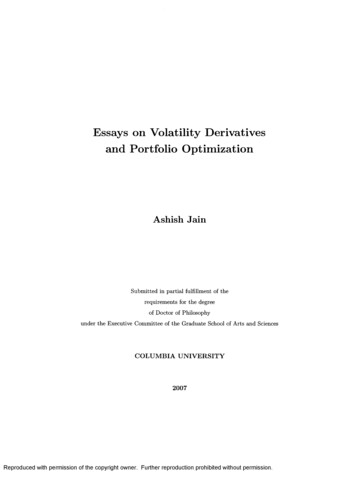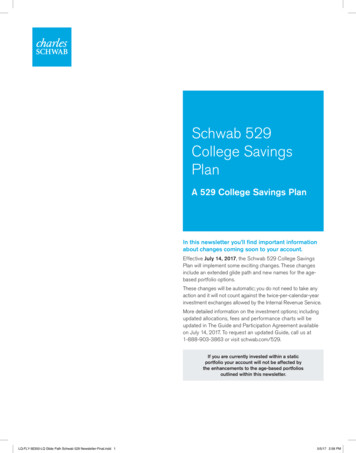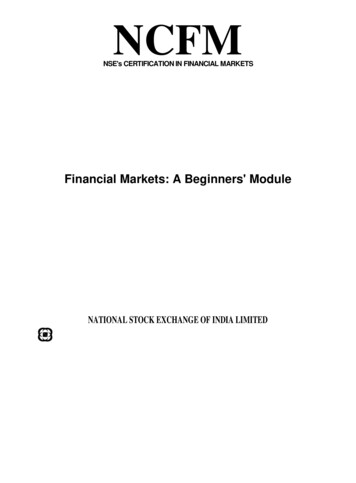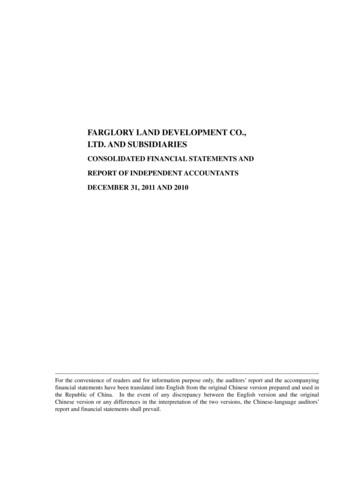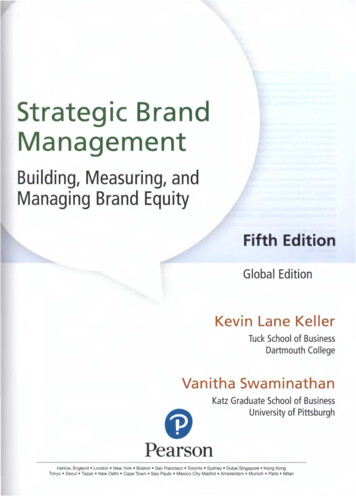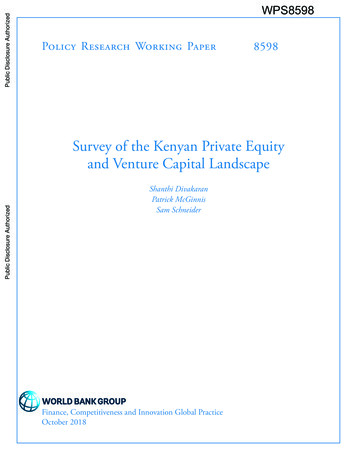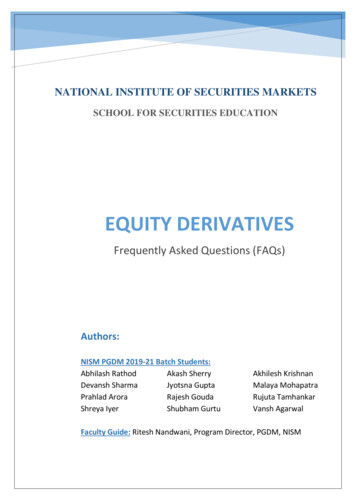
Transcription
NATIONAL INSTITUTE OF SECURITIES MARKETSSCHOOL FOR SECURITIES EDUCATIONEQUITY DERIVATIVESFrequently Asked Questions (FAQs)Authors:NISM PGDM 2019-21 Batch Students:Abhilash RathodAkash SherryDevansh SharmaJyotsna GuptaPrahlad AroraRajesh GoudaShreya IyerShubham GurtuAkhilesh KrishnanMalaya MohapatraRujuta TamhankarVansh AgarwalFaculty Guide: Ritesh Nandwani, Program Director, PGDM, NISM
Table of ContentsSr.No.TopicQuestionNumbersPage No1Introduction to Derivatives1-1622Understanding Futures & Forwards17-4293Understanding Options43-66204Option Properties66-90295Options Pricing & Valuation91-95396Derivatives Applications96-125447Options Trading Strategies126-271538Risks involved in Derivatives trading272-28286283-32990Clearing & Settlement in India330-345105Annexures : Key Statistics & Trends-113910Trading, Margin requirements &Position Limits in India1 P a g e
I. INTRODUCTION TO DERIVATIVES1. What are Derivatives?Ans. A Derivative is a financial instrument whose value is derived from the value of anunderlying asset. The underlying asset can be equity shares or index, precious metals,commodities, currencies, interest rates etc. A derivative instrument does not have anyindependent value. Its value is always dependent on the underlying assets. Derivatives canbe used either to minimize risk (hedging) or assume risk with the expectation of somepositive pay-off or reward (speculation).2. What are some common types of Derivatives?Ans. The following are some common types of derivatives:a) Forwardsb) Futuresc) Optionsd) Swaps3. What is Forward?A forward is a contractual agreement between two parties to buy/sell an underlying assetat a future date for a particular price that is pre‐decided on the date of contract. Both thecontracting parties are committed and are obliged to honour the transaction irrespective ofprice of the underlying asset at the time of delivery. Since forwards are negotiated betweentwo parties, the terms and conditions of contracts are customized. Forwards contracts arenegotiated bilaterally between two parties in Over the counter (OTC) markets and are nottraded on the Stock Exchange.4. What are Futures?A futures contract is similar to a forward, except that the deal is made through an organizedand regulated stock exchange rather than being negotiated directly between two parties.Forwards and Futures contracts are discussed in detail in Part II of the document2 P a g e
5. What are Options?An Option is a contract that gives the right, but not an obligation, to buy or sell theunderlying on or before a stated date and at a stated price. While buyer of option pays thepremium and buys the right so write off the contract at any time whereas the writer/sellerof option receives the premium with an obligation to sell/ buy the underlying asset, if thebuyer exercises his right.6. What are the types of Options?There are two types of Options, Call Options and Put OptionsA call option gives, the holder, the right to buy a specified quantity of the underlying assetat the strike price on a predetermined date.A put option, on the other hand, gives, the holder, the right to buy a specified quantity ofthe underlying asset at the strike price on a predetermined date.Options are discussed in detail in Part III of the document7. What are various underlying asset classes on which Derivatives contracts exist?Ans. The following are some popular underlying asset classes on which Derivativescontracts exist: Equity Commodities Interest rates CurrenciesPopular Derivatives Contracts3 P a g e
8. What are major segments on which Derivatives are traded?Ans.i) Exchange Traded Markets - Exchange-traded Market is platform where thecontracts are standardized, traded on organized exchanges with prices determinedby the interaction of buyers and sellers through anonymous auction platform. Aclearing corporation, guarantees contract performance (settlement of transactions).ii) Over the Counter (OTC markets) - Over the Counter (OTC) derivative contractsare signed between the two parties without going through the platform of a stockexchange or any other intermediary. OTC is the term used to refer stocks that tradethrough a separate dealer. These are well known as unlisted stocks where thesecurities are traded by broker-dealers through over the counter negotiations.9. What is the history of evolution of Global Derivatives markets?4 P a g e
10. How big the Derivatives markets are globally?The global financial derivatives markets are estimated to be over 4,500 trillion U.S.dollars, for the year 2019, based on the yearly turnover on notional value basis. (Source:Bank of International Settlements and World Federation of Exchanges).Annexure 1 of the document contains key statistics with regard to the size and growthof global financial derivatives markets.11. How big are Equity Derivatives markets in India?Ans. The total turnover in exchange traded equity derivatives markets stand at over Rs.3,400 lakh crores, on the basis of Notional Value of the contracts, for the F.Y. 2019-20.(Source: SEBI Annual Report).Annexure 2 of the document contains key statistics with regard to the size and growth ofIndian equity derivatives markets.12. How have the Equity Derivatives grown in India over last 15 years? Between yearx and year YAns. Over the last 15 years, the total turnover in exchange traded equity derivativesmarkets has grown exponentially at a CAGR of 33% from Rs. 48 lakh crores in F.Y.2005-06 to Rs. 3,450 lakh crores in F.Y. 2019-20.Annexure 2 of the document contains key statistics with regard to the trend of Indianequity derivatives markets.5 P a g e
13. How does the size of Exchange traded Equity Derivatives compare with the size inthe Equity Cash market? How has it changed over past few years?Ans. For F.Y. 2019-20, the yearly turnover on exchanges in equity derivatives markets(based on notional value) is approximately 35 times the yearly turnover in equity cashmarkets. The trend has been more or less same for last few years. The equity derivativesmarket and equity cash market has grown with a CAGR growth of 39.24% and 19.42%respectively since F.Y. 2013-14 till F.Y. 2019-20. The data with regard to same iscaptured in Annexure 2 of the document.14. What is the significance and impact of Derivatives markets?Ans. Like other segments of Financial Market, Derivatives Market serves followingspecific functions: Derivatives market helps in improving price discovery of the underlying based on actualvaluations and expectations. Derivatives market helps in transfer of various risks from those who are exposed to riskbut have low risk appetite to participants with high risk appetite. For example, hedgerswant to give away the price risk of the underlying where as traders are willing to takethis risk. Derivatives market helps shift of speculative trades from unorganized market toorganized market. Risk management mechanism and surveillance of activities ofvarious participants in organized space provide stability to the financial system.15. What are the factors contributing to growth of Derivatives markets globally?Ans. Over the last four decades, financial derivatives markets have seen a phenomenalgrowth. Many new derivative products and contracts have been launched at exchangesacross the world. Some of the factors driving the growth of financial derivatives are: Increased fluctuations in underlying asset prices in financial markets. Integration of financial markets globally. Use of latest technology in communications has helped in reduction of transaction costs.6 P a g e
Enhanced understanding of market participants on sophisticated risk management toolsto manage risk. Frequent innovations in derivatives market and newer applications of products.16. What are some major contributors in growth of Derivatives markets in last 5decades?Ans. Besides other developments in global economy and financial markets, the followingare some of the major events and developments which lead to immense growth ofDerivatives markets: End of Bretton woods SystemIn August 1971, U.S. President Richard Nixon announced the "temporary"suspension of the dollar's convertibility into gold. While the dollar had struggledthroughout most of the 1960s within the parity established at Bretton Woods, thiscrisis marked the breakdown of the system. Since the collapse of the Bretton Woodssystem, IMF members have been free to choose any form of exchange arrangementthey wish (except pegging their currency to gold): allowing the currency to floatfreely, pegging it to another currency or a basket of currencies, adopting thecurrency of another country, participating in a currency bloc, or forming part of amonetary union. (Source : IMF Website) Free flow of CapitalAs countries has opened up their economies for the global players to enter themarket. This move has increased the flow of capital in the derivatives marketsignificantly. Advent of TechnologyThe advent of technology has helped in minimizing the footfall on the physicalexchange platform and increase in participation through virtual platforms in order7 P a g e
to reach the mass potential market players with an ease. It not only helps in reducestime and cost for everyone but also helps in better price discovery of the financialderivatives. Introduction of new productsIntroduction of products in the derivatives market have played a major role indevelopment of global derivatives market as people get more opportunities toparticipate in the derivatives market. Products like Swaps & Swaptions, IndexDerivatives, Credit Derivatives and other complex derivative products are some ofthe key introductions to the global derivatives market.8 P a g e
II. FUTURES & FORWARDS17. What are forward contracts?Ans. A forward contract is a customized contract between two parties to buy or sell an assetat a specified price on a future date. A forward contract can be used for hedging orspeculation, although its non-standardized nature makes it particularly apt for hedging.Now, let us take an example to furthermore explain this:Suppose you are a farmer and you want to sell wheat at the current rate of Rs.18 per kg, butyou know that wheat prices will fall in the coming months ahead.In this case, you enter a contract with a grocery for selling them a particular amount ofwheat at Rs.18 in three months. By entering into the said contract, you are able to eliminatethe uncertainties of your revenues on account of prices of wheat in futures.Now, if the price of wheat falls to Rs.16 after three months, then you are protected fromthe potential losses since you will still be able to sell the wheat at the agreed price of Rs.18 per kg. However, on the other hand, if the price of wheat rises to Rs. 20 after threemonths, then you will be devoid of the potential profits because you will still sell the wheatat the agreed price of Rs. 18 per kg as per the forward contract.18. Why is forward contracting important?Ans. Forward contracting is very valuable in hedging and speculation. If a speculator hasinformation or analysis which forecasts an upturn in a price, then he can go long on theforward market instead of the cash market. The speculator would go long on the forward,wait for the price to rise, and then take a reversing transaction making a profit.19. What are futures contracts?Ans. A futures contract is an agreement to either buy or sell an asset on a publicly-tradedexchange. The contract specifies when the seller will deliver the asset, and what the pricewill be. The underlying asset of a futures contract is commonly either a commodity, stock,bond, or currency.9 P a g e
Futures markets are exactly like forward markets in terms of basic economics. However,contracts are standardized and trading is centralized (on a stock exchange). There is nocounterparty In futures markets, unlike in forward markets, increasing the time toexpiration does not increase the counter party risk. Futures markets are highly liquid ascompared to the forward markets.20. What are standardized contracts?Ans. Futures contracts are standardized. In other words, the parties to the contracts do notdecide the terms of futures contracts; but they merely accept terms of contracts standardizedby the exchange.21. What are customized contracts?Ans. Forward contracts (other than a futures) are customized. In other words, the terms offorward contracts are individually agreed between two counter-parties.22. What are the key differences between forwards and futures?BASIS FORFORWARD CONTRACTFUTURES CONTRACTForward Contract is an agreementA contract in which the parties agreebetween parties to buy and sell theto exchange the asset for cash at aunderlying asset at a specified datefixed price and at a future specifiedand agreed rate in future.date, is known as future contract.What is it?It is a tailor made contract.It is a standardized contract.Traded onOver the counter, i.e. there is noOrganized stock exchange.COMPARISONMeaningsecondary market.SettlementOn maturity date.On a daily basis.RiskHighLow10 P a g e
BASIS FORCOMPARISONDefaultFORWARD CONTRACTAs they are private agreement, theFUTURES CONTRACTNo such probability.chances of default are relativelyhigh.Size of contractDepends on the contract terms.FixedCollateralNot requiredInitial margin required.MaturityAs per the terms of contract.Predetermined dateRegulationSelf-regulatedBy stock exchangeLiquidityLowHigh23. What are the major specifications of a futures contract?Ans.ExpirationExpiration (also known as maturity or expiry date) refers to the last trading day of thefutures contract. After the expiry of a futures contract, final settlement and delivery ismade according to the rules laid down by the exchange in the contract specificationsdocument.Contract SizeContract size, or lot size, is the minimum tradable size of a contract. It is often one unitof the defined contract.Initial MarginInitial margin is the minimum collateral required by the exchange before a trader isallowed to take a position. Initial margins can be paid in various forms as laid down bythe exchange and varies from assets to assets as well as from time to time. The level of11 P a g e
initial margin is dependent on the price volatility of the contract. More volatilecommodities generally have higher margin requirements.Price QuotationPrice Quotation is the units in which the traded price of a contract is displayed. It canbe different from the trading size of a contract and is often based on industry practicesand conventions.Tick ValueTick Value refers to the minimum profit or loss that can arise from holding a positionof one contract. Tick value depends on the size of the contract and its tick size. Whileit is often explicitly mentioned in contract specifications, it can be calculated by theformula:Tick Value Contract Size x Tick SizeMark to MarketMark to market refers to the process by which the exchange calculates and values allopen positions according to pre-defined rules and regulations. Mark-to-market is anessential feature of exchange-traded futures contracts whereby the exchange ensuresthat all profit and losses are recognized by pricing them according to accurate marketconditions. It is also an important feature for the risk management of positions ofparticipants.Delivery DateDelivery date or delivery period refers to the time specified by the exchange during orby which the seller has to make delivery according to contract specifications andregulations. Delivery date is often later than expiry date of a contract, especially in caseof physically delivered commodities.Daily SettlementDaily settlement refers to the process whereby the exchange debits and credits allaccounts with daily profits and losses as calculated by the mark-to-market process.12 P a g e
Daily settlement is necessary in order to recover losses and pay profits to respectiveaccounts.24. What are the limitations of forward contracts?Ans. Forward markets worldwide are afflicted by several problems:(a) Lack of centralisation of trading,(b) Illiquidity, and(c) Counterparty risk.25. What are the limitations of futures contracts?Ans. Some investment strategies can lead to high risks due to the leverage provided byfuture contracts It usually follows set standards for defined amounts and terms giving lessflexibility options in investing Only partial hedging is facilitated by future contracts The consequence of low commission charges can be over-trading by traders26. Which are the two positions one can take in a futures contract?Ans. One can take Long and Short positions in futures contract.Having a “long” position in a security means that you intend to buy the security in future.Investors maintain “long” security positions in the expectation that the stock will rise invalue in the future. The opposite of a “long” position is a “short” position.A "short" position means that you intend to sell the security in future. Investors maintainshort position in an expectation that the price of the stock will decrease in value in future.13 P a g e
27. What are the payoffs and profits for a long futures holder?Ans. A payoff is the likely profit loss that would accrue to a market participant with changein the price of the underlying asset. Futures contracts have linear payoffs. In simple words,it means that the losses as well as profits, for the buyer and the seller of futures contracts,are unlimited. Further, the profits of one party is exactly equivalent to the losses of the otherparty.The payoff for a person who buys a futures contract is similar to the payoff for a personwho holds an asset. He has a potentially unlimited upside as well as a potentially unlimiteddownside.Take the case of a speculator who buys a two-month Nifty index futures contract when theNifty stands at 11600.The underlying asset in this case is the Nifty portfolio. When the index moves up, the longfutures position starts making profits, and when the index moves down it starts makinglosses.Chart 2.1Profit/Loss for a Long Futures Positions400300Profit/Loss 18001190012000NIFTY-300-400The figure above shows the profits/losses for a long futures position. The investor boughtfutures when the index was at 11600. If the index goes up, his futures position starts makingprofit. If the index falls, his futures position starts showing losses.14 P a g e
28. What are the payoffs and profits for a short futures holder?Ans. The payoff for a person who sells a futures contract is similar to the payoff for aperson who shorts an asset. He has a potentially unlimited upside as well as a potentiallyunlimited downside. Take the case of a speculator who sells a two-month nifty index futurescontract when the nifty stands at 11600. The underlying asset in this case is the niftyportfolio. When the index moves down, the short futures position starts making profits, andwhen the index moves up, it starts making losses.Chart 2.2Profit/Loss for a Short Futures Positions400300Profit/Loss 18001190012000NIFTY-300-400The figure shows the profits/losses for a short futures position. The investor sold futureswhen the index was at 11600. If the index goes down, his futures position starts makingprofit. If the index rises, his futures position starts showing losses.29. Which stocks are eligible for futures trading? Why is the stock list restricted tospecific scrips only?Ans. At present, we have enabled selected stocks for trading in the futures segment. Onlythose stocks, which meet the criteria on liquidity and volume, and which are proposed byStock Exchanges and approved by SEBI based on such criteria, are made available fortrading in derivatives segment.15 P a g e
30. What are the benefits of trading in index futures compared to any othersecurity?Ans. Investor can trade the ‘entire stock market’ by buying index futures instead ofbuying individual securities with the efficiency of a ‘risk diversification’.The advantages of trading in Index Futures are: The contracts are highly liquid Index Futures provide higher leverage than any other stocks It has lower risk than buying and holding stocks It is just as easy to trade the short side as the long side Only have to study one index instead of 100s of stocks Indices, as underlying, are relatively less volatile than single stocks. Also, Indices, in some cases, can be used to hedge for a portfolio exposure, provided theportfolio has good correlation with the Index31. What determines the fair price of a futures contract?Ans. The pricing of a futures contract depends upon the underlying's price, the cost of carry,and expected dividends. For simplicity, suppose no dividends are expected, Nifty is at10,000 and the one-month interest rate is 1%. Then the fair price of an index futures contractthat expires in a month is 10,100.32. What is a contract cycle?What is bull spread (futures)?Ans. In most commodities and financial derivatives market, the term refers to buyingcontracts maturing in nearby month, and selling the deferred month contracts, to profit fromthe wide spread which is larger than the cost of carry.33. What is bear spread (futures)?Ans. In most of commodities and financial derivatives market, the term refers to selling thenearby contract month, and buying the distant contract, to profit from saving in the cost ofcarry.16 P a g e
34. What is ‘Contango’?Ans. Contango means a situation, where futures contract prices are higher than the spotprice and the futures contracts maturing earlier.In the chart below, the spot price is lower than the futures price which has generated anupward sloping forward curve. This market is in contango - the futures contracts are tradingat a premium to the spot price. Futures contracts may be in a contango because offundamental factors like storage, financing (cost to carry) and insurance costs.Chart 2.3Source: CME Group35. What is ‘Backwardation’?Ans. Backwardation means a situation, where futures contract prices are lower than thespot price and the futures contracts maturing earlier.In the chart below, the spot price is higher than future prices and has generated a downwardsloping forward, or inverted, curve which is in backwardation.Chart 2.417 P a g e
Source: CME Group36. What is Basis?Ans. It is normally calculated as cash price minus the futures price. A positive numberindicates a futures discount (Backwardation) and a negative number, a futures premium(Contango). Unless otherwise specified, the price of the nearby futures contract month isgenerally used to calculate the basis.For example, when Nifty futures trades at 12,120 and the spot Nifty is at 12,000, "the basis"is said to be 100 points or 1%.37. What is Cash settlement?Ans. It is a process for performing a futures contract by payment of money difference ratherthan by delivering the physical commodity or instrument representing such physicalcommodity38. What is Offset?Ans. It refers to the liquidation of a futures contract by entering into opposite (purchase orsale, as the case may be) of an identical contract.18 P a g e
39. What is settlement price?Ans. The settlement price is the price at which all the outstanding trades are settled, i.e,profits or losses, if any, are paid. Normally it is a weighted average of prices of transactionsboth in spot and futures market during specified period.40. What is convergence?Ans. This refers to the tendency of difference between spot and futures contract to declinecontinuously, so as to become zero on the date on maturity.41. Do futures price converge to the spot prices closer to the date of expiry? Why?Ans. As the futures get closer to expiry, the prices will naturally converge. This is becausethe futures price is in effect a price in the future (the price at expiry) that takes into accountthe cost of carry. If this premium or discount gets out of equilibrium the forces of supplyand demand will react.For example if a physical commodity is way above the futures price, this will bring inarbitragers, speculators and hedgers who will buy the “cheap” futures contract, rather thanthe physical commodity; this will create demand for the futures contract pushing the priceup towards the physical. In addition the high price of the physical will be under pressuredue to the fact that users can buy the “cheaper” futures. Less demand for the physical meansthe price comes down again pushing the markets towards convergence or prior to expiry aform of “balance”.19 P a g e
III. OPTIONS42. What are Call Options?Ans. A call option gives the holder (buyer/ one who is long call), the right to buy a specifiedquantity of the underlying asset at the strike price on the expiration date. The seller (onewho is short call) however, has the obligation to sell the underlying asset if the buyer of thecall option decides to exercise his option to buy.Example: An investor buys One European call option on Stock "A" at the strike price ofRs. 3500 at a premium of Rs. 100. If the market price of Stock "A" on the day of expiry ismore than Rs. 3500, the option will be exercised. The investor will earn profits once theshare price crosses Rs. 3600 (Strike Price Premium i.e. 3500 100). Suppose stock priceis Rs. 3800, the option will be exercised and the investor will buy 1 share of Stock "A"from the seller of the option at Rs 3500 and sell it in the market at Rs 3800 making a profitof Rs. 200 {(Spot price - Strike price) - Premium}.In another scenario, if at the time of expiry stock price falls below Rs. 3500 say suppose ittouches Rs. 3000, the buyer of the call option will choose not to exercise his option. In thiscase the investor loses the premium (Rs 100), paid which shall be the profit earned by theseller of the call option.43. What are Put Options?Ans. A Put option gives the holder (buyer/ one who is long put), the right to sell a specifiedquantity of the underlying asset at the strike price on or the expiry date. The seller of theput option (one who is short put) however, has the obligation to buy the underlying asset atthe strike price if the buyer decides to exercise his option to sell.Exa-mple: An investor buys one European Put option on Stock 'B' at the strike price of Rs.300, at a premium of Rs. 25. If the market price of Stock 'B', on the day of expiry is lessthan Rs. 300, the option can be exercised as it is 'in the money'. The investor's Break-evenpoint is Rs. 275 (Strike Price - premium paid) i.e., the investor will earn profits if the market20 P a g e
falls below 275. Suppose stock price is Rs. 260, the buyer of the Put option immediatelybuys Stock 'B' from the market @ Rs. 260 & exercises his option selling the Stock 'B' at Rs300 to the option writer thus making a net profit of Rs. 15 {(Strike price - Spot Price) Premium paid}.In another scenario, if at the time of expiry, market price of Stock 'B' is Rs 320; the buyerof the Put option will choose not to exercise his option to sell as he can sell in the marketat a higher rate. In this case the investor loses the premium paid (i.e. Rs 25), which shall bethe profit earned by the seller of the Put option.44. What is option premium?Ans. Option Premium is the price paid by the buyer to the seller to acquire the right to buyor sell. The Option Premium paid is the maximum loss a Buyer can ever make andrepresents the maximum profit the Seller can ever make. In simpler terms, the price ofoptions contract is known as Option Premium.45. What is strike price?Ans. The strike or exercise price of an option is the specified/ predetermined price of theunderlying asset at which the same can be bought or sold if the option buyer exercises hisright to buy/ sell on or before the expiration day.Suppose you buy a call of Nifty at the strike of Rs. 12,500 at a premium of Rs. 50. Nifty iscurrently trading at 12,300. You believe that the Nifty will cross 12,500 before expiry. Soat the point when it crosses 12500, you will exercise your right. Also, since you have paida premium of Rs. 50 for buying the call, you start making profits when Nifty crosses 12,550(12,500 50).21 P a g e
46. What is an expiration date?Ans. The date on which the option expires is known as the Expiration Date. On theExpiration date, either the option is exercised or it expires worthless.47. What is the exercise date?Ans. The date on which the option is actually exercised is called the Exercise Date. In caseof European Options, the exercise date is the same as the expiration date while in case ofAmerican Options, the options contract may be exercised any day between the purchase ofthe contract and its expiration date (see European/ American Option)48. What is Open Interest?Ans. Open Interest is the total number of derivatives (futures & options) contractsoutstanding in the market at any given point of time. It is the total number of F&O contractsthat are not closed or delivered on a particular day.49. How open interest is different from the traded volumes?Ans. Open Interests is not the same as the traded volumes. Volumes are the quantity tradedfor a specific period and gives us an idea about the activity for that given period. Openinterests are outstanding positions and hence tells us about the level of interest in aparticular counter. Open interests tells us about the depth in the market.50. What do you mean by an option holder or buyer?Ans. Option Holder: is the one who buys an option, which can be a call, or a put option.He enjoys the right to buy or sell the underlying asset at a specified price on or beforespecified time. His upside potential is unlimited while losses are limited to the premiumpaid by him to the option writer.22 P a g e
51. What do you mean by option writer or seller?Ans. Option seller/ writer: is the one who is obligated to buy (in case of put option) or tosell (in case of call option), the underlying asset in case the
1 P a g e Table of Contents Sr. No. Topic Question Numbers Page No 1 Introduction to Derivatives 1-16 2 2 Understanding Futures & Forwards 17-42 9 3 Understanding Options 43-66 20 4 Option Properties 66-90 29 5 Options Pricing & Valuation 91-95 39 6 Derivatives Applications 96-125 44 7 Options Trading Strategies
